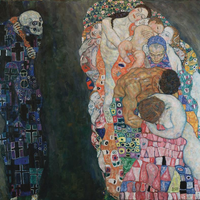More about African't

Contributor
African’t is one of those art pieces that creeps into the depths of your soul and freaks you out for the next 2-3 weeks, which was completely Walker’s intention.
The 66 foot long creation is the perfect combination of gigantic and really hard to look at as it’s full of black stereotypes, sex, and violence . As our lady and our love, Barbara Kruger put it, Walker is “determined to show the unseen and speak the unspoken and to do so with a brilliant and astute understanding of how dominance subjugates us and how wit and brutal humor can save us.” And this is especially the case with the piece, African’t. It shows the brutality that black people have endured including violence, sexual and otherwise, and slander. One of the images that make up African’t, is of a black woman pooping and vomiting bones of the people she was said to have cannibalized. Another is of her among the monkeys that she was said to have resembled and of her being raped by a white man while his white wife does nothing to help her. Walker is really good at not leaving anything out while still forcing you to think of the nonfiction from which this silhouette certainly came. Hence the 2-3 week heebie jeebies. It takes a true mastermind to use your imagination as her medium.
And as a reward for this brilliance, Walker won the MacArthur “genius” Fellowship - the youngest person ever to do so. The art world worried that Walker would peak too soon. They discouraged her from doing too many shows or accepting too many awards, but it’s been twenty years and we are still waiting for that plateau/decline. What do critics know anyway?
Sources
- "African't | The Broad". Thebroad.org. Web. 30 June 2017.
- "Kara Walker (B. 1969) , African't". Christies.com. Web. 30 June 2017.
- Barnett, Laura. "Kara Walker's Art: Shadows Of Slavery". the Guardian. N.p., 2013. Web. 30 June 2017.

Contributor
Like most of Walker’s famed cut paper silhouette installations, African’t details gruesome and fanciful depictions of race relations in the antebellum South and colonial Africa.
Hyperbole and fantasy tint historical fact with disturbing caricature in this installation that spans the walls of a gallery at the Broad Museum. A cannibalized white man roasts over a fire, while across the room a black woman sh*ts and vomits out the bones of what might have been one of his pals. Other grisly details swirl around them. It’s a shocking comment on the violence and absurdity of racism, and a great environment for a demented game of I Spy.
Walker routinely addresses histories of racism, sexual exploitation and violence in her work. Though her chosen subject matter is tragic, there are moments in Walker’s work where you can glimpse a dark-but-silly sense of humor through the gore. African’t speaks to her penchant for punny titles. Walker says a title is like a “sideshow act...a queasy invitation to this uncomfortable space.” Transforming the nightmarish into something cartoonish is a trick she has mastered, although not everyone gets it--and most are certainly not comfortable with it. “[My work] makes people queasy," she says. "And I like that queasy feeling."
Sources
- Barnett, Laura. “Kara Walker’s Art: Shadows of Slavery.” The Guardian. Accessed 1/25/17. https://www.theguardian.com/artanddesign/2013/oct/10/kara-walker-art-sh…
- Cathy Curtis. “Outlining the Past.” Los Angeles Times. October 14, 1997. http://articles.latimes.com/1997/oct/14/entertainment/ca-42541
- Matthea Harvey, “Kara Walker.” Bomb Magazine. Summer 2007. http://bombmagazine.org/article/2904/kara-walker












